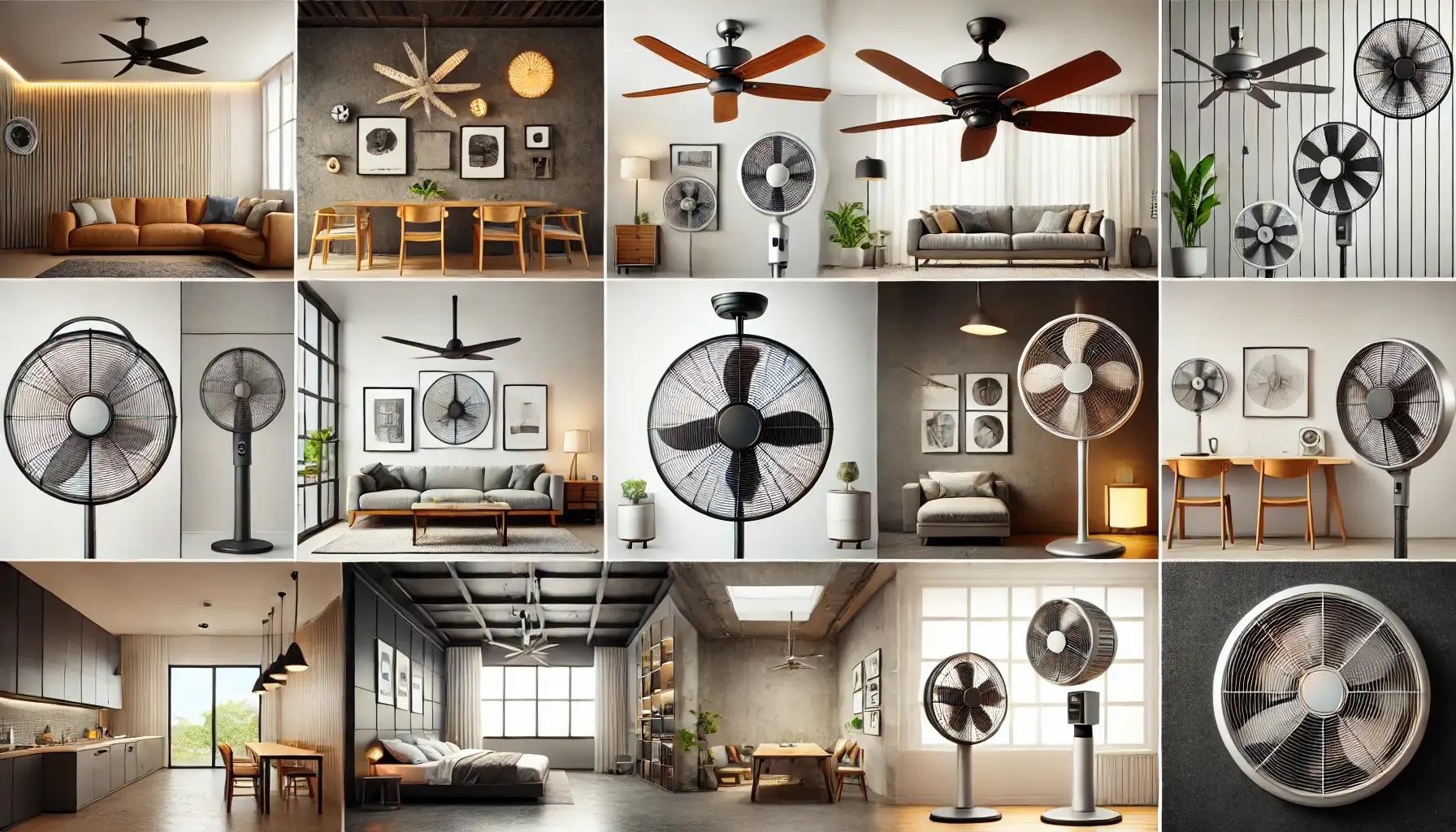Fans are essential devices used to circulate air, helping to cool down a space or improve ventilation. From homes and offices to industrial and commercial settings, fans serve as a practical solution for enhancing comfort and air circulation. They come in a wide variety of types and designs, each suited for different purposes and environments.
Whether you’re looking to stay cool during summer, improve air circulation, or simply find an energy-efficient cooling solution, selecting the right type of fan can make a significant difference.
Importance of Choosing the Right Fan Type
Choosing the right fan isn’t just about cooling your space—it’s about optimizing comfort, energy efficiency, and even aesthetics. The type of fan you choose can affect:
- Airflow: The amount of air circulation in your space.
- Energy Usage: How much power the fan consumes.
- Noise Levels: Especially important in spaces like bedrooms or offices.
- Design and Fit: Does it match the room’s decor? Is it appropriate for your room size?
By selecting the correct fan type, you not only improve the functionality of your space but also enhance the overall atmosphere, making it more pleasant and enjoyable.
What You’ll Learn in This Guide
In this comprehensive guide, we’ll explore the different types of fans available on the market. From ceiling fans and pedestal fans to exhaust fans and tower fans, we’ll cover everything. You’ll also learn how to choose the right fan for your specific needs, including key features to look for and how to maintain them for optimal performance.
Categorization Types of Fans
Fans come in many different forms, each suited to specific purposes and environments. To better understand how fans are categorized, we can break them down based on their functionality, placement, and power source. This will give you a comprehensive view of the fan options available.
Based on Functionality
Fans can be classified according to how they work or are powered:
- Mechanical Fans: These fans are manually operated and rely on physical force for airflow. You might find them in vintage designs or small handheld models where electricity isn’t used. However, these are less common today.
- Electrical Fans: The most prevalent type, electric fans use motors to create airflow. These fans vary from small desktop models to large industrial machines, powered through an electrical outlet.
Based on Placement
Where you plan to place the fan plays a crucial role in determining which type is best suited for your needs. Here’s a quick breakdown of placement-based fan types:
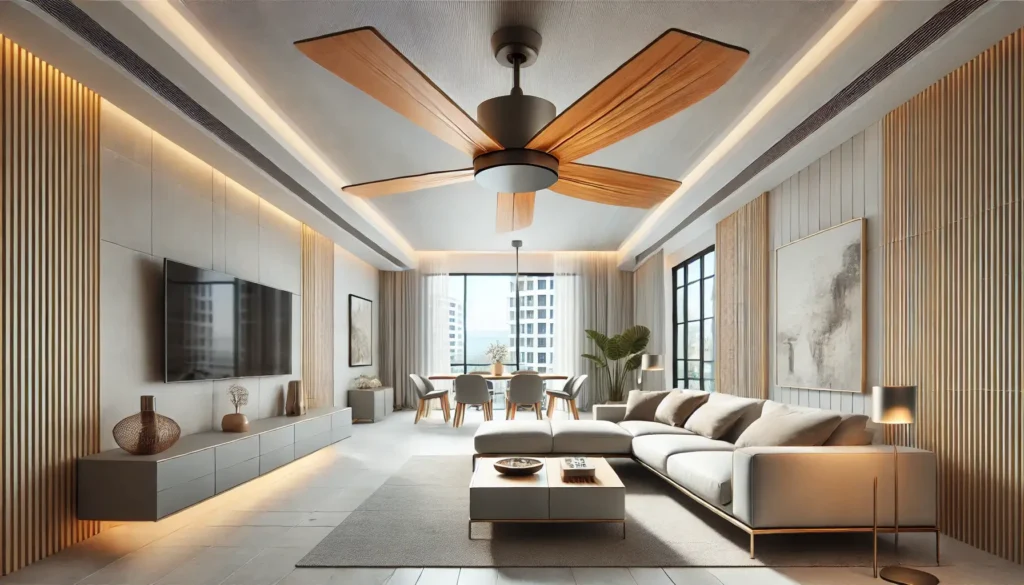
Ceiling Fans:
Mounted on the ceiling, ceiling fans are ideal for large rooms such as living rooms, bedrooms, and offices. They are typically designed with long blades to circulate air efficiently over a wide area.
Best Features: Energy-efficient, often come with integrated lighting, and are a staple for year-round use as they help with both cooling and heating (when run in reverse).
Wall-Mounted Fans:
These fans are fixed to the wall, saving floor space while still providing adequate air circulation. Wall-mounted fans are commonly used in areas where floor space is limited, such as gyms, offices, or garages.
Best Features: Space-saving design and ideal for areas with heavy traffic or tight spaces.
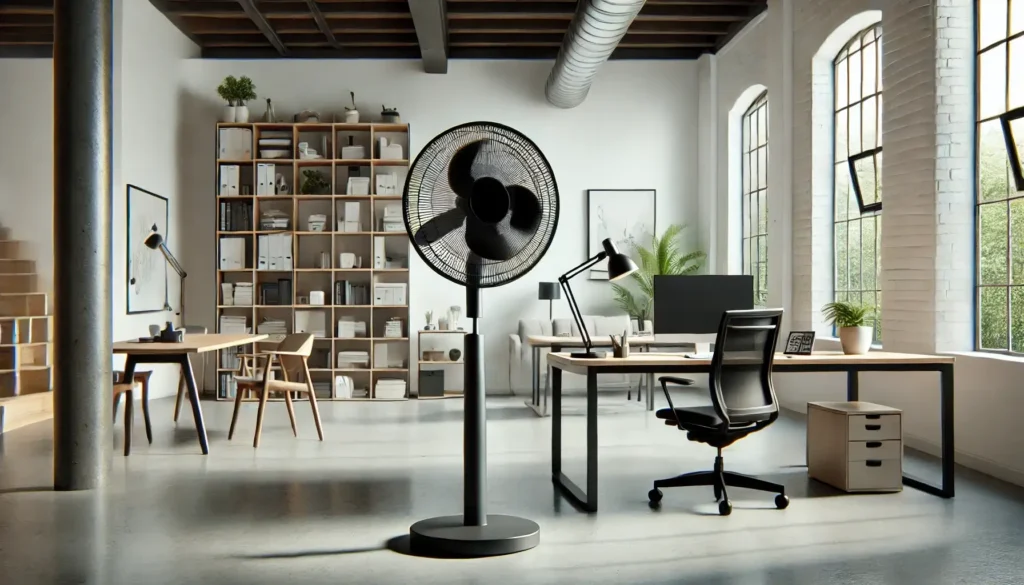
Pedestal Fans:
Pedestal fans are freestanding fans, usually with an adjustable height. Their oscillating head allows them to distribute air across larger spaces, making them perfect for living rooms, large offices, or outdoor gatherings.
Best Features: Portable, adjustable height, and powerful airflow.
Table Fans:
As the name suggests, these fans are small and portable, perfect for placing on desks, bedside tables, or countertops. They are usually lightweight and offer personalized cooling.
Best Features: Compact, portable, and affordable.
Tower Fans:
Known for their sleek, modern design, tower fans are perfect for smaller rooms or areas where floor space is limited. They stand vertically and offer efficient airflow with minimal noise.
Best Features: Space-saving design, quiet operation, and often come with remote control.
Window Fans:
Installed in windows, these fans provide a dual function: they can pull in fresh air from outside or push out stale air from inside. They’re ideal for improving ventilation in small rooms.
Best Features: Improve ventilation, can be used to exhaust hot air or bring in cool air.
Exhaust Fans:
Exhaust fans are typically used to remove stale or humid air from a room. You’ll often find these in kitchens, bathrooms, or laundry rooms to vent out steam or unpleasant odors.
Best Features: Reduces humidity, improves air quality, and prevents mold buildup.
Also read The Ultimate Guide to Gaming Laptop and PC Accessories.
Based on Power Source
Different fans come with varied power options to suit different needs:
Electric Fans:
The most common type, these fans are powered by electricity. They can be plugged into a standard outlet and vary from small, portable models to larger, more permanent installations.
Best Features: Reliable, powerful, and available in a wide range of styles.
Battery-Operated Fans:
Battery-powered fans offer portability and convenience, especially when electricity isn’t available. They are ideal for outdoor activities, emergencies, or power outages.
Best Features: Portable and convenient, especially useful for outdoor or on-the-go cooling.
Solar-Powered Fans:
An eco-friendly option, solar-powered fans run on energy harnessed from the sun. While these fans tend to be more expensive initially, they offer long-term savings on energy costs.
Best Features: Energy-efficient and eco-friendly.
Industrial vs. Residential Fans
There is a notable difference between fans designed for residential use and those meant for industrial purposes. Each is built with specific needs in mind:
Residential Fans
Designed for home and office use, residential fans are built with aesthetics, noise reduction, and energy efficiency in mind. Whether it’s a ceiling fan for your living room or a table fan for your home office, these fans offer comfort and style.
Key Features: Quiet operation, energy-efficient, often come with design features that blend with interior décor.
Industrial Fans
Built for large, open spaces such as factories or warehouses, industrial fans focus on durability and airflow power. They’re larger and more robust, capable of moving air across vast areas, and often designed to withstand harsher conditions.
Key Features: High airflow capacity, durable construction, built for heavy-duty use.
Key Considerations When Choosing a Fan
When selecting the best fan for your space, here are a few things to keep in mind:
- Room Size: (H3) Larger rooms may require a powerful ceiling or pedestal fan, while smaller rooms might be best served by a compact table or tower fan.
- Airflow Needs: (H3) Do you need a fan to cool an entire room or just a personal breeze? Ceiling and pedestal fans are great for larger spaces, while tower and table fans are better for smaller, localized cooling.
- Energy Efficiency: (H3) Look for fans that are designed to be energy-efficient, especially if you plan on running them for extended periods. Solar-powered fans or fans with energy-saving features are ideal for cutting down on electricity costs.
- Noise Levels: (H3) Fans can generate noise, especially powerful or larger models. If you plan to use your fan in a quiet space, such as a bedroom or office, look for fans specifically designed for quiet operation.
In-Depth Overview of Fan Types
Now that we’ve explored how fans are categorized, let’s take a closer look at each specific fan type. This section will help you understand the unique features of each fan and where they are most effective.
Ceiling Fans
Definition and Common Uses
Ceiling fans are one of the most popular types of fans, commonly used in homes and offices. These fans are mounted on the ceiling and are designed to circulate air throughout a room. Ceiling fans are particularly effective in large spaces like living rooms, bedrooms, and offices where widespread air circulation is required.
Key Features
- Blade Size and Material: Ceiling fans come with blades of varying sizes, from 36 to 60 inches or more. The material of the blades can vary as well, from wood to metal or plastic.
- Motor Power: The motor size affects how powerful the airflow is. More powerful motors are needed for larger rooms.
- Integrated Lighting: Many ceiling fans come with built-in lights, which can help save space and serve a dual purpose as both a light source and a fan.
- Reversible Function: Some ceiling fans have a reversible feature that can help with air circulation in both summer and winter. In the summer, the fan blows air downward to cool the room, while in the winter, it circulates warm air by spinning in reverse.
Best Places to Install Ceiling Fans
- Living Rooms: A ceiling fan can help circulate cool air throughout a large living area.
- Bedrooms: Ceiling fans are a great way to stay cool while you sleep without the noise and chill of air conditioning.
- Offices: A ceiling fan can help improve air circulation in offices, creating a more comfortable working environment.
Pros and Cons
Pros:
- Efficient for cooling large spaces.
- Energy-saving in both summer and winter.
- Wide variety of designs to match your décor.
Cons:
- Requires professional installation.
- Fixed in place, lacks mobility.
Table Fans
Definition and Common Uses
Table fans are compact, portable fans that can be placed on desks, countertops, or bedside tables. These fans are perfect for personal use, offering direct airflow where it’s needed most. They are widely used in homes, offices, and even kitchens to provide quick and easy cooling.
Key Features
- Oscillation: Many table fans come with oscillating heads, allowing them to sweep air across a wider area instead of in a fixed direction.
- Multiple Speed Settings: Table fans typically offer several speed options, allowing you to control the intensity of airflow.
- Portable and Lightweight: One of the biggest advantages of table fans is their portability. They are easy to move around the house or even outdoors when needed.
Best Places to Use Table Fans
- Desks: Ideal for cooling while you work, without taking up too much space.
- Bedside Tables: A quiet table fan can be perfect for personal cooling while sleeping.
- Kitchens: Great for circulating air while cooking or handling hot tasks.
Pros and Cons
Pros:
- Affordable and portable.
- Easy to use and set up.
- Great for personal cooling in small spaces.
Cons:
- Not effective for cooling large rooms.
- Can be noisy, especially at higher speeds.
Pedestal Fans
Definition and Common Uses
Pedestal fans are tall, free-standing fans that sit on an adjustable pole, allowing them to reach higher areas and provide airflow to a larger space. Their oscillating heads help distribute air across a wide area, making them ideal for large rooms or open spaces.
Key Features
- Height Adjustability: The height of pedestal fans can be adjusted, allowing them to target airflow at different levels.
- Oscillation: Most pedestal fans oscillate, which means they can cover a broader area and provide even air distribution.
- Multiple Speeds and Settings: Pedestal fans typically offer a range of speed settings for customized cooling.
Best Places to Use Pedestal Fans
- Living Rooms: Perfect for large, open areas where wider airflow distribution is needed.
- Outdoor Spaces: Pedestal fans are easy to move and can provide relief in outdoor settings, such as patios or balconies.
- Offices and Workshops: Their ability to cover larger spaces makes them ideal for open-plan offices or workshop environments.
Pros and Cons
Pros:
- Highly portable and adjustable.
- Powerful airflow, suitable for large rooms.
- Easy to move from room to room.
Cons:
- Can be noisy, especially at higher settings.
- Takes up floor space.
Wall-Mounted Fans
Definition and Common Uses
Wall-mounted fans are designed to be installed on the wall, saving floor and desk space. These fans are ideal for areas where you need air circulation but don’t have room for a floor or table fan. Wall-mounted fans are commonly used in gyms, garages, or offices.
Key Features
- Space-Saving Design: Wall-mounted fans are fixed to a wall, freeing up valuable floor space.
- Adjustable Tilt: Many wall-mounted fans come with adjustable angles, allowing you to direct airflow to where it’s needed.
- Remote Control Options: Some wall-mounted fans come with remote control, making it easier to adjust settings without needing to reach the fan.
Best Places to Install Wall-Mounted Fans
- Gyms: Provides cooling without taking up floor space.
- Garages: Ideal for keeping air moving in workspaces without floor clutter.
- Offices: Helps circulate air in larger spaces without the need for a bulky pedestal fan.
Pros and Cons
Pros:
- Saves floor and desk space.
- Ideal for small or busy areas.
- Can be adjusted to direct air where needed.
Cons:
- Requires installation.
- Fixed in one location, lacks mobility.
Tower Fans
Definition and Common Uses
Tower fans are slim, vertical fans designed for modern living spaces. They provide efficient cooling without taking up much floor space, making them perfect for smaller rooms or areas where space is limited.
Key Features
- Sleek, Space-Saving Design: Tower fans are tall and narrow, making them ideal for tight spaces or corners.
- Quiet Operation: Tower fans are known for their quiet performance, making them great for bedrooms or offices.
- Remote Control and Advanced Settings: Many tower fans come with remote controls and additional features like timers, ionizers, and air purification.
Best Places to Use Tower Fans
- Bedrooms: Tower fans provide quiet, efficient cooling, perfect for sleep.
- Living Rooms: Their sleek design makes them a great fit in modern spaces without taking up too much room.
- Offices: Quiet and compact, they fit easily into office spaces without being intrusive.
Pros and Cons
Pros:
- Space-saving design.
- Quiet operation, ideal for sensitive environments.
- Often feature additional functions like timers and air purifiers.
Cons:
- Limited airflow compared to pedestal or ceiling fans.
- May not be as powerful in larger rooms.
Advanced Features in Modern Fans (H2)
As technology has evolved, so have fans. Modern fans come with a variety of advanced features that enhance their functionality, energy efficiency, and user experience. In this section, we’ll explore these innovative features and what they offer.
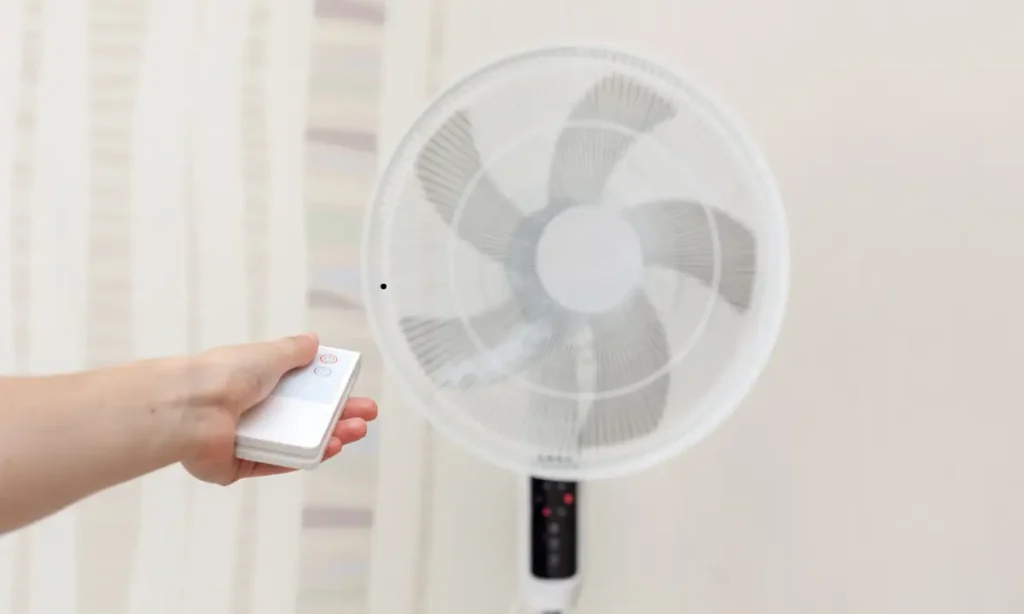
Smart Fans
Integration with Home Automation
One of the most exciting advancements in fan technology is the rise of smart fans. These fans can be connected to your home automation system, allowing you to control them remotely through your smartphone or voice assistants like Amazon Alexa or Google Assistant. This feature is perfect for those who want convenience and control, whether you’re adjusting the fan’s speed while lying in bed or turning it off when you’re away from home.
Key Benefits:
- Control the fan from anywhere via smartphone apps.
- Integrate with smart home systems to schedule fan operation based on room temperature.
- Voice control capabilities for hands-free operation.
Energy-Saving Features
Smart fans often come with additional energy-saving features such as:
- Eco Mode: Adjusts the fan speed automatically based on the room’s temperature, ensuring that the fan only uses as much energy as needed.
- Timers and Scheduling: Set specific times for the fan to turn on or off, reducing unnecessary usage and saving electricity.
Energy Efficiency in Fans
Energy Star-Rated Fans
Many modern fans now come with Energy Star certification, meaning they meet strict energy efficiency guidelines set by the U.S. Environmental Protection Agency (EPA). These fans use significantly less energy while still providing strong airflow.
Key Benefits:
- Lower electricity bills over time.
- Environmentally friendly due to reduced energy consumption.
- Reliable performance without sacrificing airflow.
BLDC (Brushless Direct Current) Motor Fans
Fans with BLDC motors are becoming increasingly popular due to their superior energy efficiency compared to traditional AC motor fans. BLDC motors generate less heat and use less power, making them an excellent choice for long-term savings.
Advantages:
- High Efficiency: Uses up to 70% less energy than traditional fans.
- Longer Lifespan: Less heat generation means less wear and tear on the motor, extending the life of the fan.
- Quiet Operation: BLDC motors are quieter, making them ideal for bedrooms or offices.
Noise Levels
Fans with Quiet Operation
While fans are great for keeping you cool, the noise they generate can sometimes be disruptive—especially in places like bedrooms, offices, or study areas. Thankfully, many modern fans are designed with quiet operation features. These fans are engineered to minimize motor noise without compromising on performance.
Where to Use Quiet Fans:
- Bedrooms: Ensure a peaceful night’s sleep without loud whirring sounds.
- Offices: Maintain a calm, distraction-free workspace.
- Libraries or Study Rooms: Ideal for areas that require concentration and quiet.
Comparing Fan Noise Levels
Fan noise is often measured in decibels (dB), and choosing a fan with a low dB rating can make all the difference. Look for fans that have noise levels of around 40-50 dB, which is equivalent to soft background noise.
Remote Control and Advanced Features
Remote Control Options
Many modern fans, especially pedestal, tower, and ceiling fans, come with remote controls. This feature adds convenience by allowing users to control the fan speed, oscillation, and timer settings without having to physically interact with the fan.
- Key Features:
- Change fan speed settings with the touch of a button.
- Activate or stop oscillation from across the room.
- Set timers to automatically shut off the fan after a set period.
Timers and Sleep Modes
Another great feature in modern fans is the inclusion of timers and sleep modes. These allow you to program the fan to turn off after a certain period, which is especially useful for overnight use. Some fans even have a sleep mode that gradually decreases the fan speed as you drift off, optimizing comfort while conserving energy.
Air Purification and Additional Features
Fans with Air Purifiers
Some modern tower and pedestal fans come with built-in air purification systems. These fans not only circulate air but also clean it, removing allergens, dust, and pollutants from the environment. This feature is particularly beneficial for those with allergies or respiratory issues.
Key Features:
- Integrated HEPA filters to remove dust, pollen, and smoke from the air.
- Ionizers that help neutralize airborne particles, improving indoor air quality.
Fans with Humidifiers
In addition to air purification, some fans offer a humidifying function, which helps add moisture to the air. This can be a great addition during dry seasons or in regions with low humidity, improving the overall comfort of your living space.
Where to Use These Fans:
- Living Rooms: Ideal for improving air quality and comfort in frequently used spaces.
- Bedrooms: Perfect for those who experience dry skin or nasal passages while sleeping.
- Allergy Sufferers: Helps to reduce allergens in the air while providing cooling.
How to Choose the Right Fan for Different Spaces
Selecting the right fan depends largely on the size of the room, the specific airflow requirements, and where the fan will be used. In this section, we’ll look at different types of spaces and which fan types are best suited for them.
Fans for Large Rooms
Large spaces, like living rooms, open-plan offices, and outdoor areas, require fans that can move significant amounts of air to ensure proper cooling and circulation. Here are some fan options to consider:
Ceiling Fans
For large indoor spaces, ceiling fans are one of the best options. They provide consistent, widespread airflow across the room. If the room is exceptionally large, you might even consider multiple ceiling fans for better coverage.
- Best for: Living rooms, large bedrooms, or office spaces.
- Tips: Choose a ceiling fan with a blade span of at least 52 inches for rooms larger than 225 square feet. Look for fans with multiple speed settings and a reversible motor for year-round use.
Pedestal Fans
Pedestal fans are a versatile solution for large rooms, especially if you need mobility. These fans are powerful and adjustable, making them ideal for shifting airflow across various parts of a room.
- Best for: Large living rooms, offices, and outdoor spaces like patios.
- Tips: Choose an oscillating pedestal fan to cover more area, and make sure it has a wide base for stability.
Industrial Fans
If you’re looking to cool a particularly large or open area like a garage, warehouse, or workshop, industrial fans are your best bet. These fans are built to handle demanding conditions and can move much more air than residential fans.
- Best for: Garages, warehouses, workshops, or large commercial spaces.
- Tips: Look for models with high airflow (measured in cubic feet per minute, or CFM) and a durable design that can withstand heavy usage.
Fans for Small Rooms
In smaller spaces, such as bedrooms, offices, or kitchens, you’ll need fans that can fit the area without overpowering it. Compact fans that provide focused airflow are ideal here.
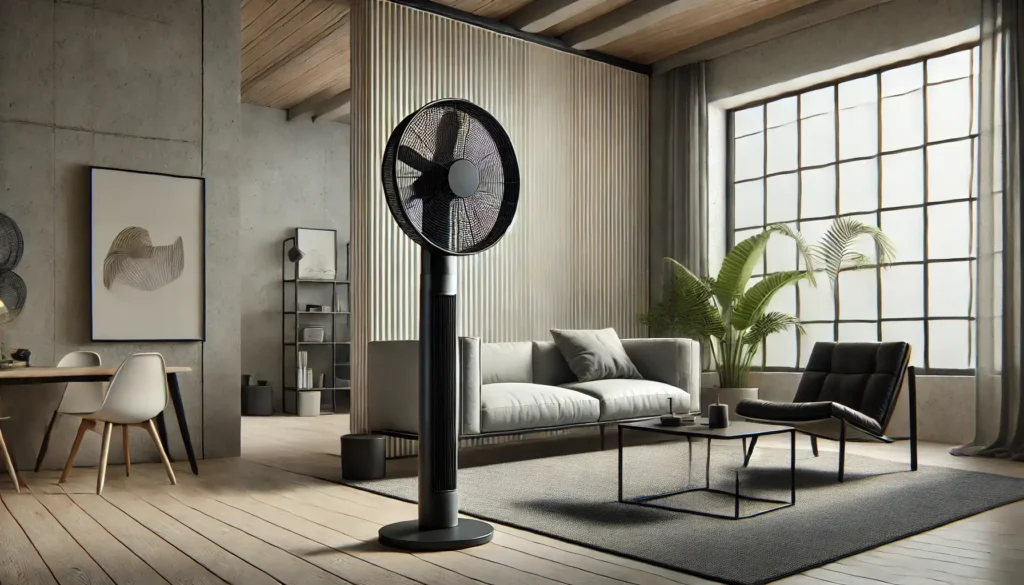
Tower Fans
Tower fans are perfect for small rooms due to their slim, vertical design. They take up minimal floor space but still offer strong airflow and multiple settings. Many tower fans also come with additional features like timers, remote controls, and air purifiers, which can add extra value.
- Best for: Bedrooms, small living rooms, and office spaces.
- Tips: Choose a tower fan with a quiet mode for sleeping and look for one with an oscillation feature to ensure even airflow.
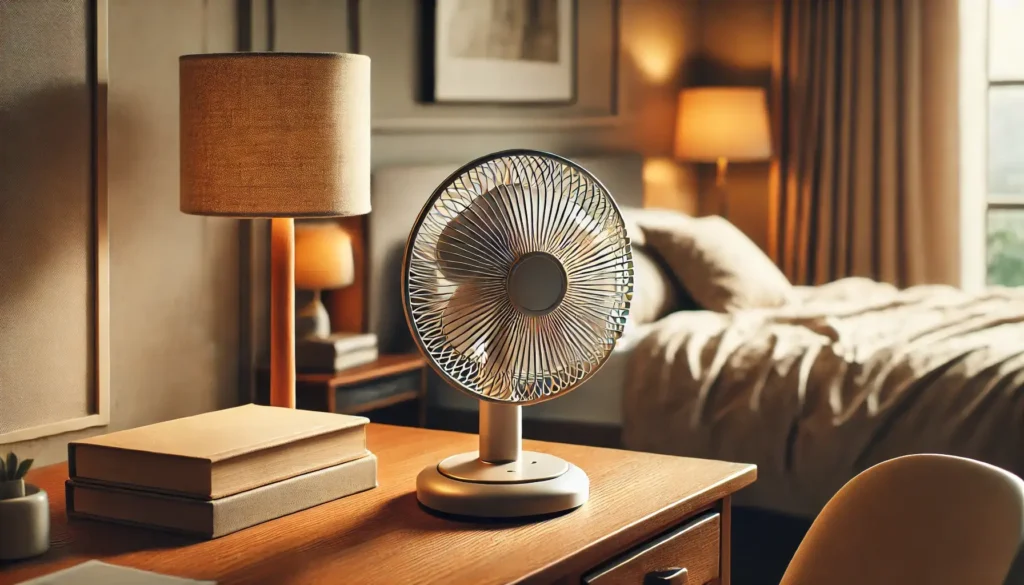
Table Fans
If you’re working in a small office or need personal cooling in a bedroom or study, table fans are an excellent choice. They’re portable and easy to move, providing direct airflow wherever you need it.
- Best for: Bedrooms, offices, or kitchen countertops.
- Tips: Look for table fans with multiple speed settings and an adjustable head so you can direct airflow exactly where you need it.
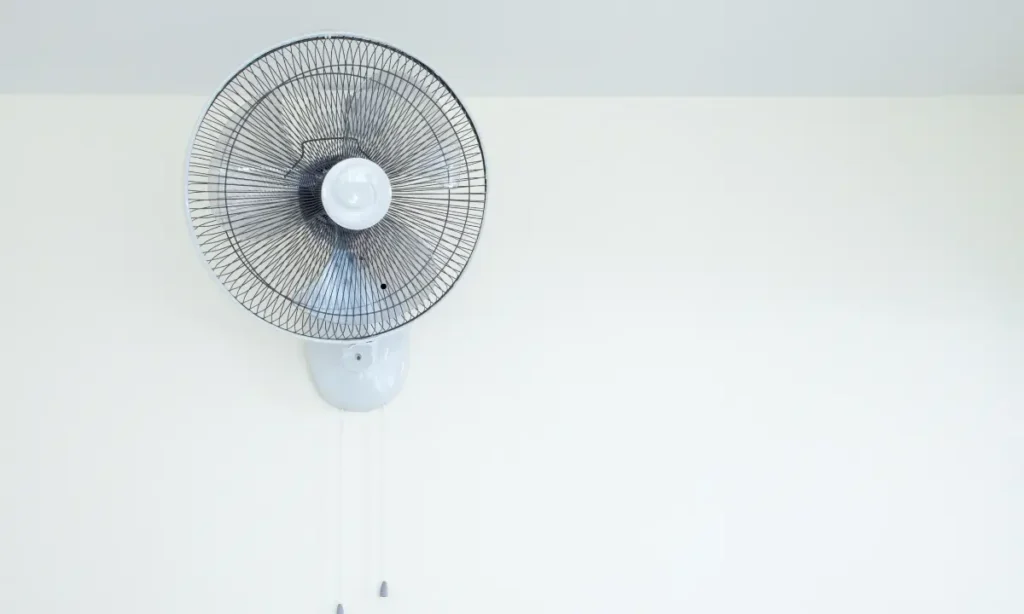
Wall-Mounted Fans
For small rooms where floor and desk space is limited, wall-mounted fans can be a great solution. These fans are fixed to the wall and provide excellent airflow without taking up any floor space.
- Best for: Small offices, bedrooms, or garages.
- Tips: Ensure the fan has an adjustable angle and oscillation to direct airflow where it’s needed most.
Outdoor Fans
Cooling outdoor spaces requires fans that are specifically built to withstand the elements while providing enough airflow to keep you comfortable in open air.
Outdoor Ceiling Fans
Outdoor ceiling fans are designed to handle the elements, with weatherproof blades and motors that resist rust and moisture. These fans are perfect for cooling down porches, patios, or verandas.
- Best for: Covered patios, porches, or outdoor living spaces.
- Tips: Make sure the fan is UL-rated for damp or wet locations. Choose a fan with large blades to ensure it can move enough air in an outdoor environment.
Pedestal or Industrial Fans
If you’re hosting a gathering or working outdoors, a heavy-duty pedestal or industrial fan can provide the power needed to circulate air in a larger outdoor space. These fans are typically more robust and can handle the demands of open-air cooling.
- Best for: Outdoor events, workshops, or large patios.
- Tips: Look for outdoor-rated fans that are designed for durability and weather resistance. Choose models with adjustable height and oscillation to cover more area.
Energy Efficiency Considerations
No matter the room size, it’s important to factor in energy efficiency when choosing a fan. Efficient fans not only save on energy costs but also reduce your carbon footprint. Here are a few tips on choosing energy-efficient fans:
Choose Energy Star-Rated Fans
Energy Star-rated fans are designed to use less electricity without sacrificing performance. These fans can save you money over time, especially if you run them for extended periods.
- Best for: All types of rooms, especially those where fans will be used frequently.
- Tips: Look for the Energy Star label when shopping for fans, and choose models with energy-saving features like timers and eco modes.
BLDC Motor Fans for Efficiency
Fans with BLDC motors use less power than traditional AC motor fans. These fans are quieter, consume less electricity, and have a longer lifespan.
- Best for: Bedrooms, living rooms, or offices where fans are used regularly.
- Tips: Invest in a BLDC motor fan if energy savings are a priority. These fans are perfect for those who run their fans for long periods without wanting to compromise on performance.
Noise Considerations
The noise a fan generates can significantly impact your comfort, especially in spaces like bedrooms or offices where silence is key. If you’re concerned about fan noise, here’s what to keep in mind:
Quiet Fans for Bedrooms and Offices
Many fans are designed with quiet operation features, making them ideal for environments where you need a peaceful atmosphere. Tower fans, ceiling fans with DC motors, and some high-quality pedestal fans are specifically engineered to run quietly.
- Best for: Bedrooms, offices, libraries, or study areas.
- Tips: Look for fans that operate below 50 decibels for quiet performance. Fans with multiple speed settings often run quieter at lower speeds, making them suitable for nighttime use.
Noise Levels in Large Spaces
In larger or more active spaces, like living rooms or outdoor areas, noise levels might be less of a concern. In these cases, you can focus on finding fans that provide strong airflow, even if they generate a bit more noise.
- Best for: Living rooms, outdoor spaces, or garages.
- Tips: Check product specifications for noise ratings if you need a balance between power and noise.
Maintenance and Care for Different Types of Fans
To ensure your fan runs smoothly and lasts for years, regular maintenance and care are key. Different types of fans have specific needs when it comes to cleaning and upkeep, and in this section, we’ll cover everything from basic cleaning to troubleshooting common problems.
General Maintenance Tips
Regular maintenance helps your fan perform efficiently, reduces noise, and extends its life. Here’s how to keep your fan in top shape:
Cleaning Fan Blades and Housing
Over time, dust and dirt can accumulate on your fan’s blades, reducing efficiency and potentially causing the fan to run noisily. Cleaning the blades and housing should be done every few months, especially if the fan is used frequently.
- Ceiling Fans: Use a microfiber cloth or duster to clean the blades. For heavier dirt or buildup, a gentle soap solution can be applied.
- Pedestal, Table, and Tower Fans: Remove the grille (if applicable) and wipe down the blades. For tower fans, use a vacuum with a soft brush attachment to clean the vents.
- Exhaust and Window Fans: Make sure to clean both the intake and exhaust sides of the fan, as these tend to accumulate more dust and debris. A damp cloth or vacuum can be used for this purpose.
Lubricating Moving Parts
Some older fans or industrial models may require lubrication to keep the motor and moving parts running smoothly. If your fan starts to squeak or doesn’t rotate as easily, it may need oiling.
- Ceiling Fans: Check the motor housing for an oil hole and apply fan oil if needed (most modern ceiling fans are sealed and don’t require oil).
- Pedestal and Wall-Mounted Fans: Apply a small amount of lubricant to the oscillating mechanism if the fan begins to stick or make noise during operation.
Tightening Screws and Bolts
Over time, the screws and bolts that hold the fan components together can become loose, which may lead to wobbling, rattling, or even reduced performance. Periodically check and tighten the fasteners on your fan, especially on ceiling and pedestal fans, which are prone to movement.
- Ceiling Fans: Make sure the fan blades are securely fastened to the motor and that the mounting bracket is tightly attached to the ceiling.
- Pedestal and Wall-Mounted Fans: Ensure that the base or mounting bracket is sturdy, and check that all parts are properly aligned.
Common Problems and Troubleshooting
Even with proper maintenance, fans can sometimes develop problems. Here are some common fan issues and how to troubleshoot them.
Fan Not Spinning
If your fan isn’t spinning or is rotating very slowly, there are a few potential causes:
- Electrical Issue: Check that the fan is properly plugged in and that there’s no issue with the power outlet. If you’re using a ceiling fan, verify that the switch and circuit breaker are functioning.
- Motor Overheating: In some cases, the fan’s motor may overheat, causing it to slow down or stop entirely. Turn off the fan, let it cool down, and try again after a few minutes. If the problem persists, the motor may need repair or replacement.
- Blockage or Dust Build-Up: Dust and dirt can cause the fan’s blades or motor to become blocked. Cleaning the fan can often solve this issue.
Noisy Fan Operation
A noisy fan can be distracting, but it’s often a simple issue to fix. Here’s what to check:
- Loose Screws or Bolts: Rattling or wobbling sounds are often due to loose components. Tighten the screws on the blades, housing, or mounting brackets.
- Blade Imbalance: If the fan blades are unbalanced, this can cause a knocking or wobbling noise. For ceiling fans, use a blade balancing kit to correct this issue.
- Motor Issues: If the motor is making a grinding or humming noise, it may need lubrication or, in the case of serious issues, replacement.
Oscillation Issues
If your pedestal or table fan isn’t oscillating properly, the problem may lie with the oscillating mechanism:
- Check the Oscillation Knob: Ensure the oscillation feature is engaged (some fans have a switch or button for this).
- Lubrication: Apply lubricant to the oscillating joint if it seems stiff or stuck.
- Internal Gear Malfunction: In some cases, the gears that control oscillation may wear out. If this happens, the fan may need professional repair or part replacement.
Fan Replacement Considerations
Even with regular maintenance, all fans have a lifespan. Here’s when it might be time to replace your fan:
When to Replace an Old Fan
Fans, especially those with motors, experience wear and tear over time. If you notice any of the following signs, it may be time to invest in a new fan:
- Persistent Noise: If your fan continues to make unusual noises after cleaning and tightening, the motor may be worn out.
- Decreased Airflow: If the fan’s airflow has noticeably reduced and cleaning doesn’t help, the motor may be losing power.
- Age: Most fans, particularly ceiling and pedestal models, can last anywhere from 5 to 10 years. If your fan is approaching the upper end of that range, consider upgrading to a newer, more efficient model.
Signs of Wear and Tear
Look out for these signs that your fan is nearing the end of its useful life:
- Rust or Corrosion: Especially in humid environments, rust on the fan blades, housing, or motor can indicate that the fan is breaking down.
- Motor Struggles: If your fan motor is overheating or frequently shutting off, it could be a sign that the motor is failing.
- Wobbling or Imbalance: Over time, fan blades can warp or bend, leading to instability. If your fan is unbalanced despite proper care, it may be time for a replacement.
Proper maintenance is the key to extending the life of your fan and ensuring that it runs smoothly and efficiently. Regular cleaning, tightening of components, and addressing minor issues early can prevent larger problems down the road. However, when your fan starts to show signs of wear and tear, replacing it with a newer, more energy-efficient model can be a worthwhile investment.
Eco-Friendly Alternatives and Innovations in Fans
As concerns about energy consumption and environmental impact grow, manufacturers have responded by creating more eco-friendly fans with innovative features. In this section, we’ll explore some of the best environmentally friendly fan options and cutting-edge innovations designed to reduce your carbon footprint and energy use.
Energy-Saving Technologies
Modern fans are increasingly equipped with energy-efficient technologies that help reduce electricity consumption without sacrificing performance. These advancements are especially useful for those who want to save on utility bills while also making an environmentally conscious choice.
Solar-Powered Fans
Solar-powered fans are one of the most eco-friendly options available, as they utilize energy directly from the sun. These fans are perfect for outdoor spaces, greenhouses, or even off-the-grid living, and they eliminate the need for conventional electricity altogether.
How They Work: Solar panels collect energy from the sun and store it in rechargeable batteries that power the fan.
Advantages:
- No electricity costs.
- Reduces reliance on fossil fuels.
- Perfect for outdoor use in sunny areas.
Best Applications: Outdoor patios, camping, greenhouses, and areas without access to electrical outlets.
BLDC (Brushless Direct Current) Motor Technology
Fans equipped with BLDC motors are designed to use significantly less power than traditional AC motor fans. This motor technology not only reduces energy consumption but also extends the fan’s lifespan due to less friction and heat generation.
How It Works: BLDC motors use electronic controllers to manage the current supplied to the motor, reducing power wastage.
Advantages:
- Up to 70% more energy-efficient than conventional fans.
- Quieter operation due to less mechanical friction.
- Longer lifespan due to reduced wear on components.
Best Applications: Living rooms, bedrooms, and offices where fans are used frequently.
Energy Star-Rated Fans
Many modern fans carry the Energy Star certification, which means they meet strict energy efficiency guidelines set by the Environmental Protection Agency (EPA). These fans are designed to consume less electricity while providing the same cooling power as standard models.
How It Works: Energy Star fans use advanced motor designs, improved blade aerodynamics, and energy-saving modes to maximize efficiency.
Advantages:
- Reduces annual energy consumption.
- Environmentally friendly and reduces carbon footprint.
- Lowers electricity bills over time.
Best Applications: Homes and businesses where fans are used daily, particularly in large spaces.
Recyclable Materials and Sustainable Manufacturing
Another significant shift in the fan industry is the use of recyclable materials and sustainable manufacturing processes. Many manufacturers are now making efforts to reduce the environmental impact of production and the life cycle of their products.
Recyclable Fan Components
Some fans are made using recyclable materials such as aluminum or biodegradable plastics. Once the fan reaches the end of its life, these components can be recycled rather than ending up in landfills.
Advantages:
- Reduces waste and promotes a circular economy.
- Materials can be reused in the production of new products.
- Helps conserve resources and reduce environmental pollution.
Sustainable Manufacturing Practices
Manufacturers are also adopting sustainable practices in the production of fans, using energy-efficient factories, reducing emissions, and sourcing eco-friendly materials. This shift reflects a broader industry trend toward responsible manufacturing.
Advantages:
- Lower environmental impact during the production process.
- Reduction in carbon footprint and greenhouse gas emissions.
- Supports green initiatives and promotes responsible consumption.
Innovations in Airflow Design and Technology
In addition to energy-saving features, fan manufacturers are innovating in airflow design to maximize cooling efficiency while using minimal power.
Dyson Air Multiplier Technology
One of the most significant innovations in fan technology is the Dyson Air Multiplier. Instead of traditional blades, this fan uses an aerodynamic ring to create a powerful, continuous stream of air. This design not only improves airflow efficiency but also eliminates the noise and turbulence caused by spinning blades.
How It Works: Air is drawn in through a motor at the base and then amplified through the ring, producing a smooth, uninterrupted airflow.
Advantages:
- Quiet operation.
- Safer, especially for households with children and pets.
- Sleek, modern design that fits into contemporary interiors.
Best Applications: Bedrooms, living rooms, and modern office spaces.
Smart Fans with Environmental Sensors
The latest smart fans go beyond remote controls and timers. Some models are now equipped with environmental sensors that detect changes in temperature and humidity, adjusting their speed and airflow automatically to maintain optimal conditions.
How They Work: Integrated sensors monitor the room’s conditions and adjust fan settings accordingly, providing automatic climate control.
Advantages:
- Maximizes energy efficiency by only running when needed.
- Improves indoor comfort by maintaining consistent temperatures.
- Reduces manual adjustments, offering a more intuitive user experience.
Best Applications: Smart homes, offices, and environments where maintaining stable temperatures is crucial.
Eco-Friendly Fan Brands to Watch
If you’re looking for brands that focus on sustainability and innovation, here are a few noteworthy companies:
- Big Ass Fans: Known for their industrial-strength fans, Big Ass Fans offers a range of energy-efficient models designed for both residential and commercial use. They focus heavily on reducing energy consumption and improving air quality.
- Dyson: Dyson is a leader in innovation, with its Air Multiplier technology setting new standards for airflow efficiency. The brand emphasizes sleek, modern designs and energy-saving features.
- Haiku by Big Ass Fans: Haiku fans are some of the most energy-efficient ceiling fans available, using BLDC motors and smart home integration to ensure optimal energy savings.
- Hunter Fan Company: Hunter is an established brand that offers Energy Star-rated fans and focuses on producing long-lasting, eco-friendly products.
Benefits of Choosing Eco-Friendly Fans (H3)
Opting for eco-friendly fans not only helps the environment but also offers numerous advantages for your home or office:
- Energy Savings: Energy-efficient fans reduce your electricity consumption, resulting in lower utility bills.
- Long-Term Durability: Fans with BLDC motors and other advanced technologies typically have longer lifespans due to reduced wear and tear on their components.
- Improved Air Quality: Fans equipped with air purifiers or ionizers contribute to healthier indoor environments, reducing allergens and pollutants in your home.
- Support for Sustainability: By choosing recyclable or sustainably manufactured fans, you contribute to reducing waste and promoting eco-friendly initiatives.
As fan technology continues to evolve, the focus on energy efficiency, sustainability, and smart features is only growing. Whether you’re looking for a solar-powered fan for your patio or an energy-efficient ceiling fan for your living room, there are plenty of eco-friendly options that not only benefit the environment but also enhance your comfort and save on energy costs.
Conclusion
Fans have come a long way from basic air circulation devices to sophisticated, energy-efficient machines with smart features and eco-friendly designs. Choosing the right fan for your space depends on various factors such as room size, airflow needs, energy efficiency, and noise preferences. Whether you opt for a sleek tower fan for your living room or a powerful industrial fan for a workshop, understanding the different types of fans and their features ensures that you make the best decision.
By considering modern innovations like smart fans, BLDC motors, and solar-powered options, you can enjoy improved air circulation while reducing your environmental impact and energy costs. Investing in a well-maintained, energy-efficient fan is not only great for your home but also a step toward a more sustainable future.
Frequently Asked Questions (FAQs)
Fans equipped with BLDC motors are considered the most energy-efficient. These fans consume significantly less electricity than traditional AC motor fans, making them perfect for long-term use in both residential and commercial spaces. Additionally, Energy Star-rated fans also provide excellent energy efficiency and help lower electricity costs.
Ceiling fans help circulate the air in a room, allowing you to feel cooler without lowering the temperature. By using ceiling fans in conjunction with air conditioning, you can set the thermostat higher while maintaining comfort, reducing the energy your AC unit uses. In the winter, you can reverse the fan’s direction to push warm air down, reducing heating costs.
For small rooms or compact spaces, tower fans and table fans are excellent options. Tower fans are slim and take up minimal floor space while offering powerful airflow. Table fans are portable, lightweight, and perfect for personal cooling in small areas like desks or countertops.
The lifespan of a fan depends on the type and usage, but on average:
Ceiling fans can last between 10-15 years with regular maintenance.
Pedestal and table fans typically last 5-8 years.
Tower fans can last around 5-7 years.
Industrial fans can last longer, sometimes exceeding 15 years, due to their heavy-duty design. Fans with BLDC motors generally have a longer lifespan compared to those with traditional motors.
